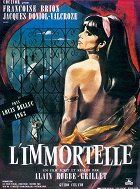Plots(1)
With its highly stylized camerawork and fragmented narrative structure, Alain Robbe-Grillet's L'IMMORTELLE is a cinematic arabesque that teases the eye with visual delights, yet sadistically confounds the viewer's expectations. Not dissimilar to Alan Resnais's Last Year at Marienbad, which he had written two years earlier, L'IMMORTELLE involves a Frenchman, traveling in Istanbul, who is fascinated by the city's language, architecture, and exotic culture. He soon becomes entranced by a mysterious woman (FranÇoise Brion) who seems to encourage his attentions but remains, maddeningly, just beyond his reach. His erotic pursuit of her leads him into the criminal underworld... with deadly consequences. (Kino Lorber)
(more)Reviews (1)
It has been said about Robbe-Grillet that: "In his works, we never have a sequence of presences that pass by, but rather a simultaneity of the presence of the past, presence of the present, and presence of the future, which make time terrible and inexplicable." Grillet thus breaks the established flow of film narration, replacing chronology with sequences of overlapping and returning shots, memories, anticipations, and brief flashes of presence that cannot be transitioned into a single reference time. The future has already always occurred, the end comes a quarter hour before the end, and the past is uncertain and perhaps did not happen at all, or it happened differently than the protagonist and the viewer had just experienced. The resulting impression is thus not primarily based on what happens in the shots themselves but on what happens BETWEEN individual shots, on the relationship between these three presences, and on the necessity for the viewer to (re)construct the hero's memories, current experiences, and anticipatory future into a single (yet impossible) unity. The second thing is the unsettling game with space. Changes in temporality lead to changes in the spatial relationships of characters and objects, achieved through repetitive variations of the same environments. Because the past, present, and future (and because Grillet edits between different present times as if it were a normal narration) have taken place (are taking place, will take place...) in the same location, the characters' locations and the course of events are constantly changing. All of this undermines the viewer's confidence in how they are accustomed to understanding storytelling and their observational abilities, making them feel uncertain.
()

